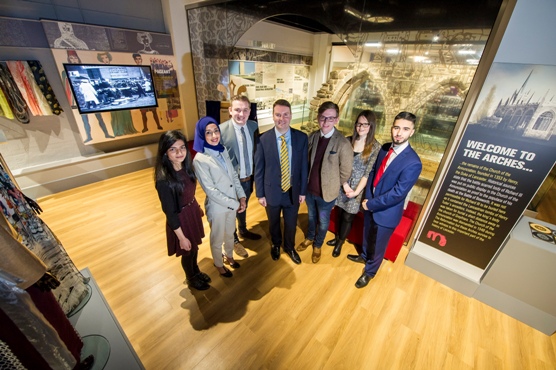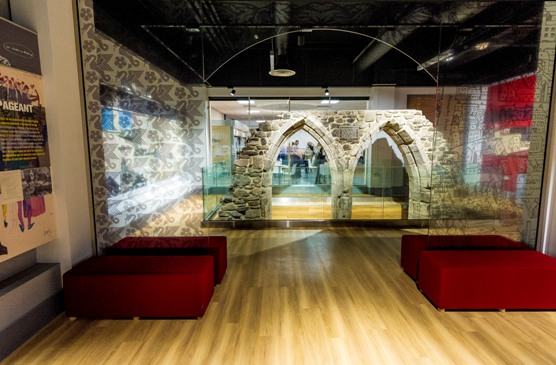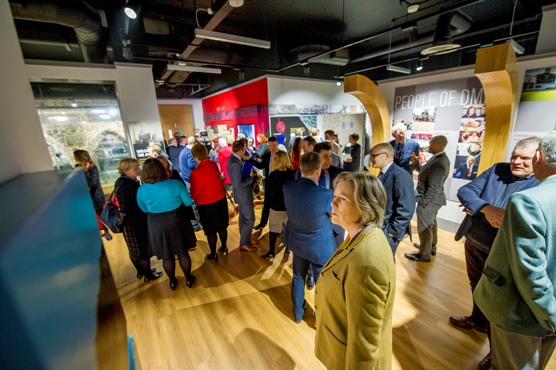The two remaining arches of Leicester’s Church of the Annunciation – famous for being where the battle-scarred corpse of Richard III was put on public display after his death at Bosworth – has formed the centrepiece of a new Heritage Centre which opened today at De Montfort University Leicester (DMU).

The DMU Heritage Centre, which is free to visit, was opened to the public for the first time today by university Vice-Chancellor Professor Dominic Shellard and students who had helped create it.
The DMU Heritage Centre celebrates the rich history of DMU – first opened as the Leicester School of Art in 1870 – and the ancient buildings that surround it dating back to the 11th Century.
The church arches were unearthed in 1935 when an extension was being built for the university’s Hawthorn Building and they have stood preserved in the basement of that building ever since.
Now an entire museum has been built around these arches as a celebration of DMU’s past, present and future, using the vast knowledge of university archivists as well as the skills of DMU Interior Design, Design Craft and Architecture students.
The DMU Heritage Centre was officially opened today on the same day that one of the university’s research teams – the Digital Building Heritage Group – revealed what the Church of the Annunciation would have looked like at the time that Richard III’s remains were laid there.
RELATED NEWS
Visit the DMU Heritage Centre website
Revealed: The church where Richard III’s body was laid
Visit DMU and see how we help you learn to succeed
During the opening Professor Shellard explained how the church arches had previously been dimly lit and surrounded by computers and vending machines and he wanted them to be celebrated rather than hidden away.
Professor Shellard then praised the students saying: “I am absolutely bursting with pride today. The centre is so visual and that is thanks to the students standing alongside me.
“We did not employ expensive consultants to create this centre, we asked our students from Design Crafts, Interior Design and architecture to help...and what a tremendous job they did.
“It is an incredible achievement to create and design something of such quality in just over a year. I am incredibly grateful to all of you.”

The third year Interior Design students were thrilled with the finished Heritage Centre.
Ra'eesah Hassan came up with the idea of the ancient map of Leicester to be etched on the glass surrounding the Hawthorn Arches. She said: "It gives a lightness and a warmth to the area, I think, and the design gives the feel of material patterns to bring in the university's art and design history."
"it's been an incredible project to be part of," added Okam Bulbul. "We each had different concepts to begin with then we came together as a design team and combined our ideas. We were given literally a blank canvas – it was a computer suite and a corridor – and went from there."
"We've been sneaking in to have a look but today is the first time we have seen it all finished," said Mallika Virenerkumar. "We are really proud of it."
Natasha Loasey said: "It is a great thing to have on your CV and we are all very grateful to DMU for giving us this opportunity."
Katharine Short, DMU archivist, who collated the exhibits and wrote their history, said: “I think what is important about the heritage centre is that it not only tells the story of the university and its history but that it tells visitors so much about Leicester and how it saw itself over the years.
“The students have done a tremendous job in bringing this all together and it has been such a fantastic project to be a part of. It has a vibrant, celebratory feel to it which hopefully will enthuse visitors about the history which surrounds us.”
The Church of the Annunciation is nationally important because not only is it connected with the death of Richard II but it also contained a number of high status Lancastrian burials.
It was also a place of pilgrimage after the King of France gave Henry the 4th Earl of Lancaster (the church founder) a thorn from the Crown of Thorns, worn by Christ at the crucifixion. This holy relic was placed on the high altar of the church on a stand of gold.
MA architecture students at DMU worked on the reconstruction with DMU Digital Building Heritage Group leader Douglas Cawthorne.

Posted on Thursday 12 March 2015